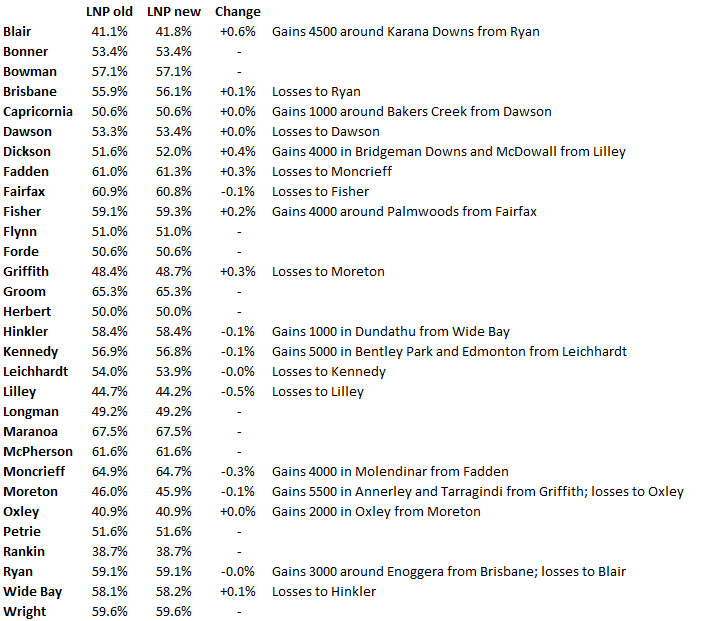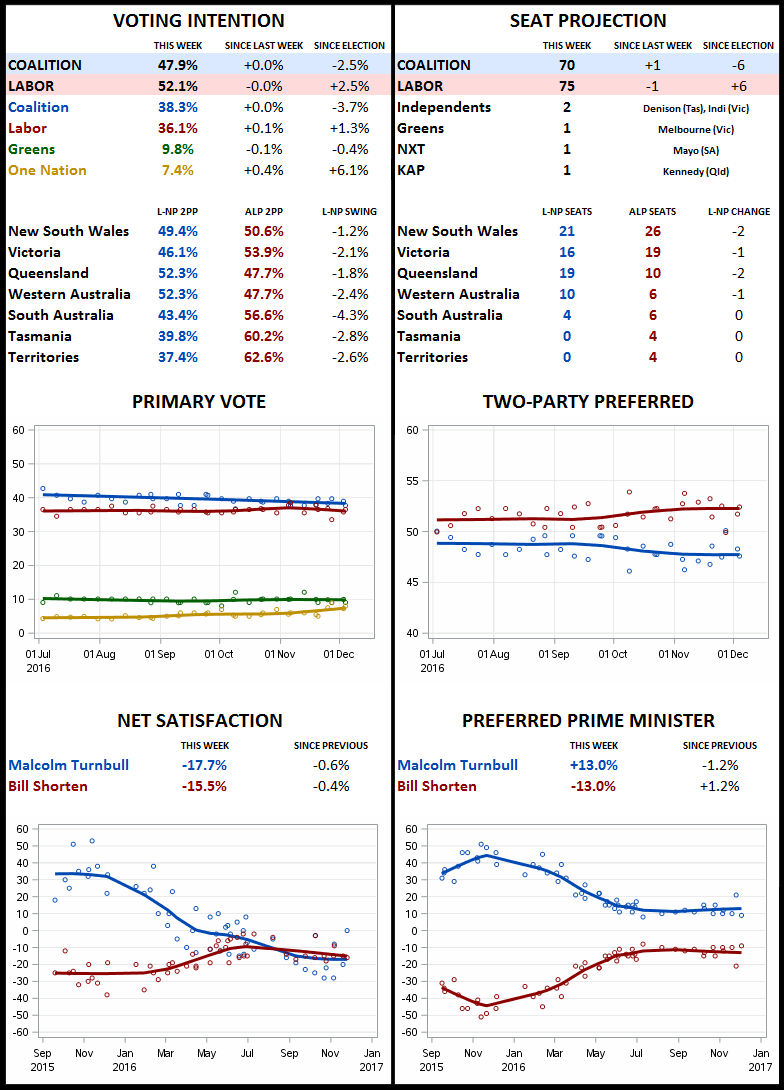Lots to report from the apple isle: new electoral boundaries, state upper house elections, and an encouraging poll for new Labor leader Rebecca White.
A helpful conjunction of events allows me to condense three pieces of Tasmanian electoral news into one post, namely the publication of draft boundaries of the state’s five federal and state electorates; tomorrow’s elections for three of the state’s 15 Legislative Council seats; and the quarterly poll of state voting intention from EMRS. In turn:
Draft electoral redistribution
Draft boundaries have been published today for a redistribution of the state’s five electorates, which, uniquely to the state, apply for both federal and state elections. A full accounting of my determinations of the new margins can be viewed here. In no case do the changes alter the existing margins by more than 1%, so the present situation where Labor holds four seats and independent Andrew Wilkie holds the fifth is notionally undisturbed. The changes can be summarised as follows:
• Bass is to be substantially altered in shape through an exchange of territory with Lyons, although it will still be dominated by Launceston. The changes are to cost it the north-eastern corner of the state (including Scottsdale and around 6000 voters overall), while adding territory to the west of the Tamar River (including Exeter, Beaconsfield and around 7500 voters all told). The areas gained and lost by Bass are conservative in roughly equal measure, so there is only a modest change to the Labor margin in Bass, from 6.1% to 6.4%.
• Braddon is to gain around 4500 voters from Lyons in the coastal area around Port Sorell, which together with the transfer to Bass costs Lyons the entirety of its territory on the north coast. This is a fairly conservative area, so Labor’s margin in Braddon is reduced from 2.2% to 1.6%.
• In addition to changes noted already, Lyons is to gain around 3500 voters from Franklin, in an area around Old Beach on the eastern bank of the Derwent River, about 10 kilometres north of central Hobart. This area is electorally typical of Franklin as a whole, so the margin in Franklin is unchanged. Lyons being less strong for Labor overall, the change makes a contribution to an overall 0.7% increase in the Labor margin there.
• Denison is to be left undisturbed.
Legislative Council elections
Tune in tomorrow for live coverage of the annual periodical elections for the Tasmanian Legislative Council, the definitive guides to which are provided by local observer Kevin Bonham. The 15 seats in this chamber are elected according to a cycle in which either two or three electorates go to the polls each May (I also observe that a redistribution is presently under way, which had previously escaped my notice, but doesn’t affect tomorrow’s poll). This system causes the chamber to be uniquely dominated by independents, with Labor and Liberal presently accounting for only two members each. One of the two Liberals, former Attorney-General Vanessa Goodwin, recently announced she was terminally ill and is shortly expected to resign, leading in due course to a by-election in her eastern Hobart seat of Pembroke.
The seats up for election tomorrow are all held by independents, each of whom is seeking re-election. Defeat for any would be highly unusual. The seats in question are:
Launceston. Rosemary Armitage came to this self-explanatory seat upon the retirement of Don Wing in 2011, running slightly behind the Liberal candidate on the primary vote but finishing well ahead after preferences. The Liberals are leaving the field vacant this time, leaving Armitage to be opposed by Brian Roe of Labor; Emma Anglesey of the Greens, who works as a staffer to Senator Peter Whish-Wilson; Matthew Allen of Shooters and Fishers; and two independents, Neroli Ellis and Mark Tapsell.
Rumney. This electorate is centred around Storm Bay about 25 kilometres east of Hobart, and includes Sorell, Richmond and Port Arthur. Lin Thorp held the seat from Labor until 1999 until her defeat in 2011, and later served in the Senate from 2012 and 2014, filling the vacancy created by the retirement of Nick Sherry and then failing to win election in 2013 from third position on the ticket. She was succeeded in Rumney by Tony Mulder, a former police commander who ran in 2011 as an independent Liberal. Mulder’s opponents are Labor’s Sarah Lovell, an organiser for United Voice; Cheryl Arnol of Shooters and Fishers; and three rival independents, Shelley Shay, Debra Thurley and hardy perennial Steve Mav.
Murchison. This electorate covers the state’s lightly populated west coast, and a stretch of the north coast inclusive of Wynyard, Smithton and Somerset (areas covered federally by Braddon). Ruth Forrest has held the seat since 2005, and her only opponent is another independent, Daryl Quilliam.
EMRS state poll
The latest phone poll of 1000 respondents for EMRS, which is the first conducted since Rebecca White replaced Bryan Green as Labor leader, has both major parties well up on the primary vote, presumably because the Liberals have benefited from a drop in support for One Nation, while White has helped Labor soak up votes from the Greens. The Liberals are up four on the primary vote to 39%; Labor is up five to 34%; the Greens are down four to 15%; and One Nation is down three to 3%. Will Hodgman holds only a narrow 42-39 lead over White as preferred premier, after dominating on this measure throughout Bryan Green’s tenure.

